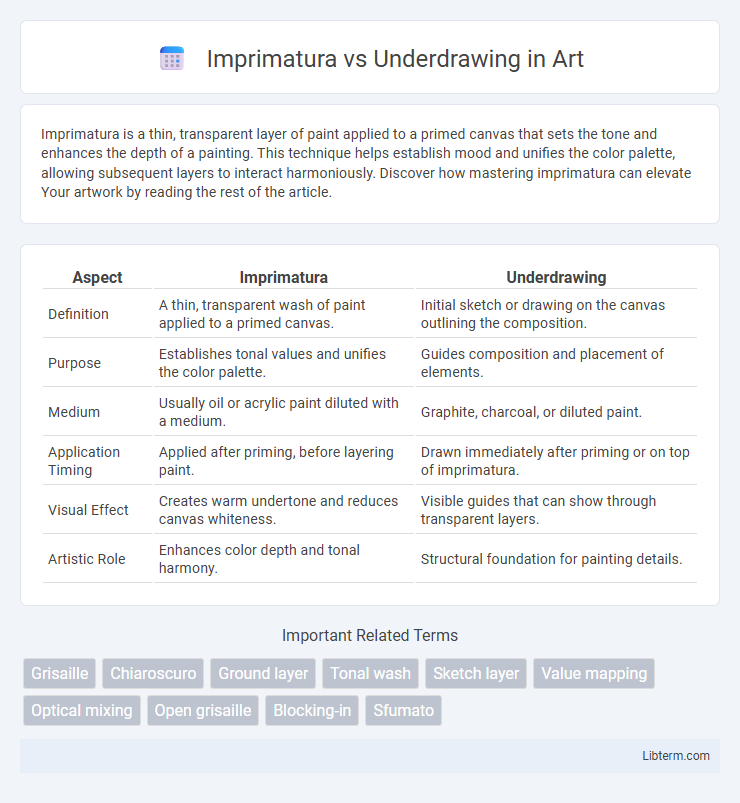Imprimatura is a thin, transparent layer of paint applied to a primed canvas that sets the tone and enhances the depth of a painting. This technique helps establish mood and unifies the color palette, allowing subsequent layers to interact harmoniously. Discover how mastering imprimatura can elevate Your artwork by reading the rest of the article.
Table of Comparison
| Aspect | Imprimatura | Underdrawing |
|---|---|---|
| Definition | A thin, transparent wash of paint applied to a primed canvas. | Initial sketch or drawing on the canvas outlining the composition. |
| Purpose | Establishes tonal values and unifies the color palette. | Guides composition and placement of elements. |
| Medium | Usually oil or acrylic paint diluted with a medium. | Graphite, charcoal, or diluted paint. |
| Application Timing | Applied after priming, before layering paint. | Drawn immediately after priming or on top of imprimatura. |
| Visual Effect | Creates warm undertone and reduces canvas whiteness. | Visible guides that can show through transparent layers. |
| Artistic Role | Enhances color depth and tonal harmony. | Structural foundation for painting details. |
Understanding Imprimatura: Definition and Purpose
Imprimatura is a thin, transparent wash of color applied to a primed canvas or panel that establishes a mid-tone base, allowing artists to build values and tones more efficiently during painting. Its primary purpose is to prevent harsh white spaces, harmonize the color palette, and create depth by providing an initial tonal warmth or coolness that influences subsequent layers. Unlike underdrawing, which emphasizes detailed sketches and outlines, imprimatura focuses on tonal foundation to guide the painting's lighting and mood.
What Is Underdrawing? Techniques and Functions
Underdrawing is a preliminary sketch applied to a painting surface to establish composition, proportions, and details before adding paint. Techniques include using graphite, charcoal, or liquid ink to create precise outlines and tonal values, often visible through transparent glazes. Its functions are to guide the painter, improve accuracy, and enhance the final artwork's depth and structure.
Historical Context: Imprimatura and Underdrawing Through the Ages
Imprimatura, originating in the Renaissance period, served as a thin, toned ground layer to unify the painting's surface and enhance luminosity, while underdrawing comprised early sketches or outlines applied directly on the panel or canvas for compositional planning. During the Middle Ages, underdrawing was predominantly used for manuscript illumination and panel paintings to define intricate details before applying paint. Both techniques evolved through the Baroque and Flemish periods, with underdrawing becoming more elaborate and imprimatura refining tonal values, reflecting advancements in artistic methods and materials.
Visual Differences: How Imprimatura and Underdrawing Appear
Imprimatura appears as a transparent, toned ground that sets the overall color temperature and value, softening the white of the canvas while allowing the subsequent paint layers to glow. Underdrawing consists of detailed sketch lines or preliminary marks made with pencil, charcoal, or paint, visible through thinner paint layers to guide composition and form. Visually, imprimatura creates a unified wash of color, whereas underdrawing reveals linear elements and contours that define the structure of the painting.
Role in Oil Painting: Imprimatura vs Underdrawing
Imprimatura serves as a transparent colored ground that establishes tonal values and unifies the composition's color harmony in oil painting, while underdrawing provides a detailed sketch that outlines shapes and guides the final paint application. Imprimatura influences the painting's overall mood by allowing the artist to control light and shadow from the start, whereas underdrawing ensures accuracy in proportions and spatial relationships. Both techniques are critical in the preparatory stages but differ in function: imprimatura sets a tonal foundation, and underdrawing directs compositional structure.
Materials and Methods for Imprimatura
Imprimatura involves applying a thin, transparent wash of oil-based or acrylic paint, typically burnt sienna or raw umber, to a primed canvas to create a warm, mid-tone base, enhancing tonal values and depth in subsequent layers. Artists use diluted paint mixtures, often thinned with turpentine or water, depending on the medium, to ensure the imprimatura layer remains translucent and allows better adhesion for the underdrawing and paint layers. This method contrasts with underdrawing, which employs dry media like charcoal, graphite, or ink directly on the primed surface to outline the composition without altering the tonal support beneath.
Common Techniques Used in Underdrawing
Common techniques used in underdrawing include hatching, cross-hatching, and contour lines to establish composition and tonal values. Artists often apply charcoal, graphite, or ink for precision and easily adjustable lines before painting. This underdrawing process provides a detailed guide that ensures accurate proportions and perspective in the final artwork.
Layering Process: Sequence of Imprimatura and Underdrawing
Imprimatura serves as the initial transparent tone wash applied to the canvas, establishing the mid-tone value and unifying the surface for consistent paint absorption. Underdrawing follows, layering detailed sketch lines over the imprimatura to map out the composition and guide subsequent paint application. This sequential layering optimizes tonal balance and structural clarity, ensuring depth and precision in the final artwork.
Artistic Effects: Impact on Mood, Color, and Texture
Imprimatura establishes a tonal base that influences the overall mood by unifying colors and enhancing warmth or coolness, creating a cohesive atmospheric effect in paintings. Underdrawing provides detailed contours and textures, guiding precision and adding depth through varying line qualities that contribute to the artwork's structural complexity. The interplay between imprimatura's color wash and underdrawing's detailed sketching shapes the final texture, balancing spontaneity with meticulous design to enrich visual interest.
Choosing the Right Approach: Imprimatura, Underdrawing, or Both?
Choosing the right approach between imprimatura and underdrawing depends on the desired painting outcome and technique. Imprimatura involves applying a transparent wash of color to unify tones and create a warm base, enhancing luminosity and depth, while underdrawing focuses on detailed sketching to establish precise composition and forms. Artists often combine both methods to balance tonal foundation with structural accuracy, optimizing control and visual harmony in their artwork.
Imprimatura Infographic

 libterm.com
libterm.com